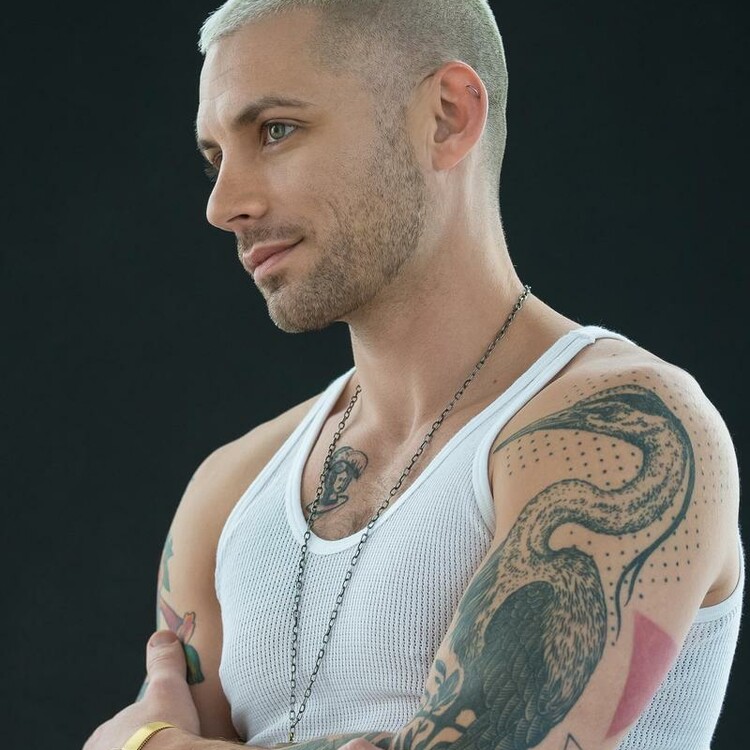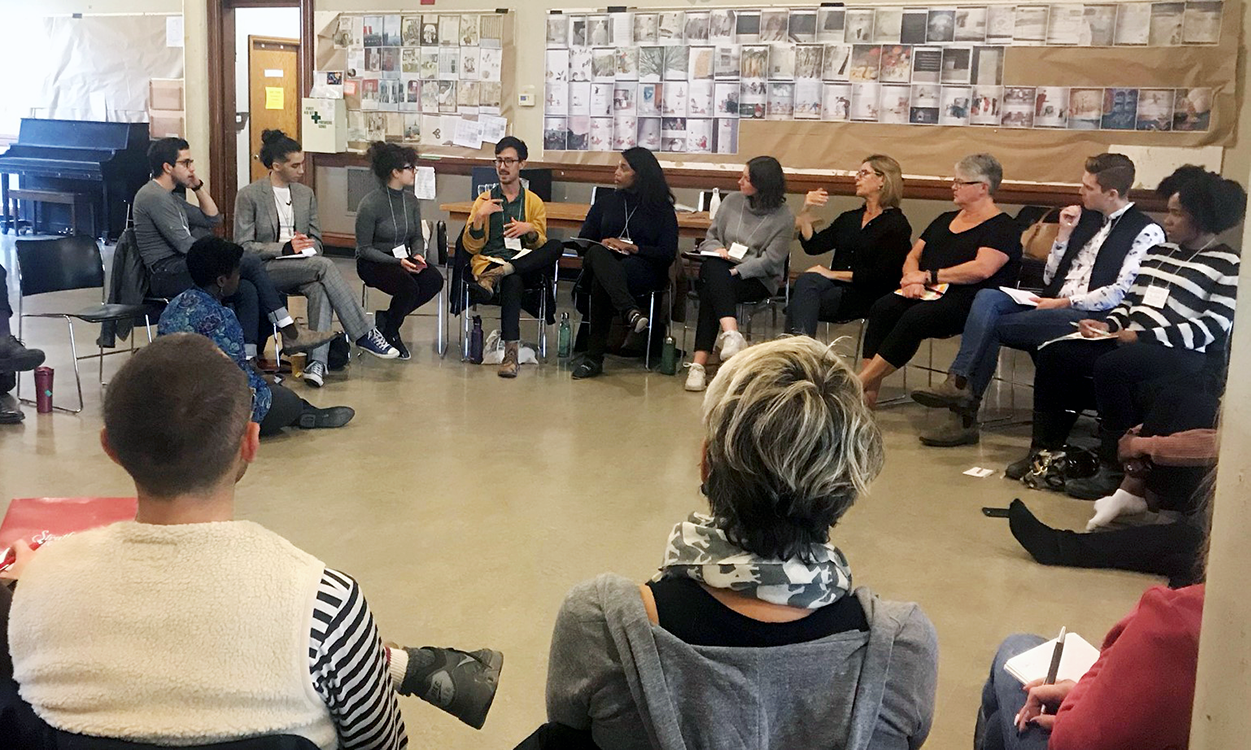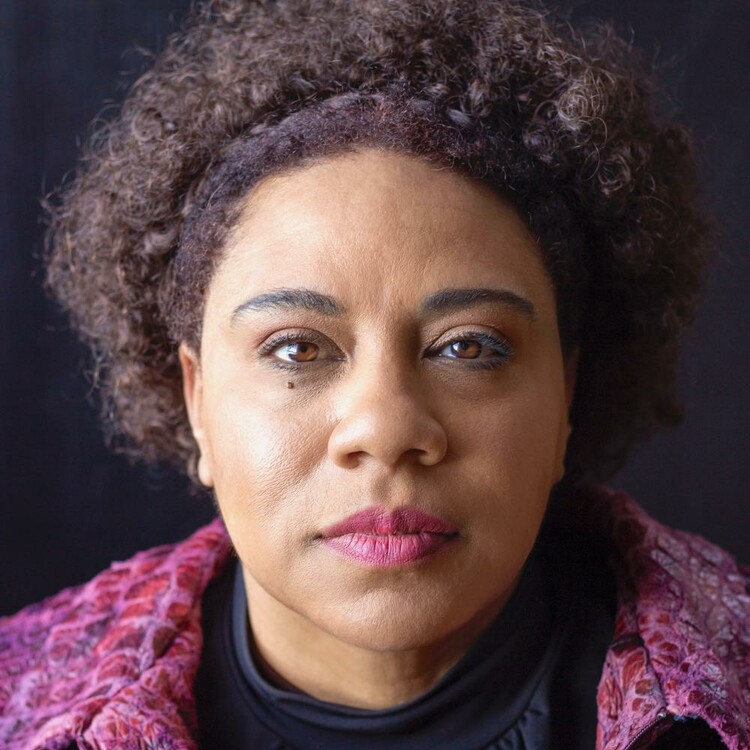With that said, the very notion of a canon can be problematic. All the works I named above, and all the listicles out there of top ten plague reads and plague films, disproportionately center white voices and white experiences. Curating canons is inherently based on a process of exclusion and is often done using metrics of “excellence” and “significance” that tend to have supremacy ideologies baked into them. Harold Bloom, who literally wrote the eponymous book on the Western canon twenty-five years ago, laments in its opening chapter about a “flight from the aesthetic” (toward the insidious dogmas of feminism and diversity) by the academic community—as though aesthetic values are objectively separable from histories of domination and empire.
In a conversation at Theatertreffen’s Stückemarkt (new play festival) in Berlin in May 2019, jury member Branden Jacobs-Jenkins (playwright of An Octoroon) was asked whether we need a new or revised canon. If Harold Bloom is a panicked preservationist, Jacobs-Jenkins is progressive and measured:
Canons, by definition, are always being revised. They are where the wars of self-definition are truly fought by every culture, every generation, and I just think we’re in the middle of some important ones right now—but I don’t think it’s anything to freak out about. I think a lot of young artists feel that in order to make themselves seen or be seen they have to ‘tear down the establishment,’ but I think it is actually about figuring out how your work might actually exist in conversation with a canon, how you might be entangled in these forces of privilege despite considering yourself dispossessed in some way. It is about sifting through your cultural inheritance and taking on what is useful to you as an artist and communicator and as a member of a social world, releasing what isn’t, and having faith in the fact that maybe these generations of theatremakers before you actually have more in common with you than in conflict.
Curating canons is inherently based on a process of exclusion and is often done using metrics of “excellence” and “significance” that tend to have supremacy ideologies baked into them.
It is this idea of a cultural inheritance that interests me in canons. At their most basic, canons are collections of works that tell us who we are and where we’ve come from. But the “we” in that construction is increasingly slippery. How we define ourselves as a collective is shifting rapidly. Whose cultural inheritance are we talking about?
We’re standing on the fault line of a seismic culture shift, with technological innovations driving massive changes in artistic expression, demographics, human migration, and information exchange (not to mention the planet on which we live). As Jacobs-Jenkins says, we’re in the midst of a battle for cultural self-definition. The centrality of the colonial Euro-Christian gaze is being challenged, and cultural genealogies are being rethought. At this cultural turning point, we’re again asking ourselves “who are we, and how did we—all of us—get here?”
########
I am the artistic associate for the Lab at the Stratford Festival. Located about a hundred kilometres west of Tkaròn:to (Toronto), on ancestral lands of the Anishinaabe, Haudenosaunee, Wendat, and Neutral Confederacy, the Stratford Festival is North America’s largest classical repertory theatre. The company’s artistic mandate has a special focus on the works of Shakespeare, but over the past seventy years it has expanded to include musicals, classical work from other traditions, and original Canadian plays.
The Lab is the festival’s research and development (R&D) wing. We’re a team of five who operate like a scrappy start-up nested inside of a large heritage organization. On one hand, we support the work of the festival by incubating new works and offering professional development opportunities. On the other, we design explorations to generate strategies and provocations to organically evolve the artistic mandate and organizational culture of the festival, with a focus on agility, holistic process, and speculative futures.
For the 2019 season, we ran the second iteration of our Lab Ensemble program. We brought together an intersectional micro-company from the acting ensemble to take part in a series of explorations and investigations. The aim for the season’s work was to help the festival reach beyond the limits of its traditional mandate—the Western canon.
With a nod to language used by Indigenous thought leaders Vanessa Andreotti and Elwood Jimmy, we collected these explorations under a mission of “gesturing toward a decolonial canon.” I am drawn to their notion of “gesturing toward” something rather than simply “decolonizing the canon,” because, as they frame it, you can’t just roll up your sleeves and vacuum up colonial legacies—they are embedded deeply into our aesthetic assumptions, our creation models, and our producing structures.
I invited seven artists to lead units exploring a body of work from their own cultural inheritance. We also engaged a group of guest artists for each unit, from the unit leaders’ artistic communities. Those units were:
- Approaching New Dramaturgies with Guillermo Verdecchia
- Indigenous Body of Work with Keith Barker
- Wole Soyinka with Tawiah McCarthy
- Toward a Trans Canon with Emma Frankland
- Plays from Modern China with Jovanni Sy & Leanna Brodie
- Latinx Perspectives with Carmen Aguirre
- A Post-Colonial Tempest with Mel Hague
I offered unit leaders a two-part prompt: “What texts and projects can you bring that (a) are ambitious in scale and scope, and (b) you could imagine being performed in mixed company?” These prompts were generated with an eye to Stratford’s own producing structures: the festival has the resources to work at scale, and its repertory model means that we assemble a company of actors to perform in multiple plays in a season rather than casting a single show. We also created a short video series on the 2019 lab ensemble, covering their work and conversations around it.
Canon in theatre dictates more than just the texts that are chosen for performance, it affects all the systems that are built to support the conditions of production and it informs the audience reception, from the architecture of our theatre spaces to our rehearsal process. In Stratford, most of the systems we work with are designed to support executing high-calibre productions of Shakespeare with a rep company.
I am drawn to their notion of “gesturing toward” something rather than simply “decolonizing the canon,” because, as they frame it, you can’t just roll up your sleeves and vacuum up colonial legacies.
The learning I hoped the project might generate could be roughly divided into three categories:
(i) People: Building relationships with artists we didn’t yet know.
(ii) Projects: Turning up texts and projects for potential future development.
(iii) Processes: Institutional learning about the protocols we might need to put in place to support artists and works coming from different backgrounds and experiences.
It was this third category that was the most challenging, and the most generative. In these conversations we had to navigate histories of oppression, exclusion, and intergenerational trauma. We had to confront our own fragilities at being asked to have these conversations and listen. I did not want this work to become an extractive exercise, mining texts and fresh new artists to work within structures that evolved with a particular theatre practice in mind. I hoped we would find ourselves thoughtfully negotiating how we come together to explore these stories.
The articles collected in this series all respond in some way to that negotiation: of bringing people together and designing collective processes to push and prod at the edges of a dominant cultural inheritance.
Keith Barker (artistic director of Native Earth Performing Arts in Tkaròn:to) and Lindsay Lachance (artistic associate for Indigenous Theatre at the National Arts Centre, on unceded Algonquin territory in Ottawa) dialogue about bringing Indigenous and settler artists together to rehearse Indigenous-authored plays, and the active reckoning with knowledge gaps about colonial violence it requires. Carmen Aguirre, playwright and associate artist at the Electric Company Theatre on Coast Salish territory (Vancouver), offers a Marxist provocation to the neoliberal current that has commodified identity politics in casting practices. Emma Frankland, a trans performance maker from the UK, offers both an account of the unit she led staging a trans takeover of the canon and a set of institutional guidelines generated by the group of 2-spirit, nonbinary, and trans performers she assembled. And finally, Sadie Berlin, the Lab’s creative assistant, poses a sharp critique of the pornographizing assumptions that require minority voices to perform marginalization through a framework of strict realism.
########
In the before, when this series was conceived, conducting R&D at a theatre of Stratford’s scale felt luxurious. The space we’d carved out to focus on social justice, agile program design, and unusual collaborative processes was something I would expect at the smaller community-driven organizations I am used to working in. And let’s be clear: it was an immense privilege. To do this work in dialogue with an anchor institution, with resources to employ artists, and without the pressure of generating anything other than learning, ideas, and relationships would have felt extravagant had it not also felt deeply necessary.
I bristle when I hear the truism that “big ships turn slowly” (usually said with a helpless shrug). There are more ways of turning than hoping the prevailing winds blow you onto a new course. Incremental change can be accelerated. Making space for R&D and learning generated through new relationships is a means of integrating evolution into your basic assumptions.
Until something like a pandemic obliterates all of those assumptions, and turns R&D into a basic state of survival.
When we return, I hope we will do so with all our senses heightened, and savor and value all the ways we negotiate sharing space with each other to tell stories again.
This isn’t the iceberg most large institutions were trying to steer away from. Changing audience demographics and buying habits, perceptions that traditional arts organizations are elitist and inaccessible, and practices and systems that affirmed those perceptions were contributing to a sense of declining relevance. Precarity, inequity, and inherited colonial practices were affecting the mental and spiritual health of artists, especially those who experience marginalization. We needed to broaden and diversify the audiences who could make meaning by participating in these institutions, while generating holistic approaches to process that empowered all artists to do their best work.
Right now, I’m not sure if we’re piling into liferafts or trying to patch our gouged hulls with duct tape and chewing gum. Now, not even the shrinking minority who still engaged with live performance can attend the theatre as they knew it. When we reach shore (okay, the big ship metaphor is officially dead now I promise) and begin to invite audiences back to sit together and breathe the same air for an evening, everything could be up for grabs.
We have an opportunity to rebuild the sector with deliberateness and care. I wonder how we will define ourselves collectively: Who will “we” have become? How many of the productions that were planned for this year will still feel important to mount? What other stories will define who we are and how we might heal? Aside from Tiger King, whose place in the canon has been strangely assured, what will be the cultural inheritance of the world to come? How will we gather around it as makers and as audiences?
The plague canon is already being revised, with different voices represented and new means of dissemination. Penguin Random House moved up the ebook launch of Saleema Nawaz’s novel Songs for the End of the World by several months when COVID hit. Like Čapek’s The White Plague, it’s an account of a novel virus with uncanny parallels to the pandemic we’re living through. But far from being too real or too cynical, it’s gentle and expansive, affirmative of the power of connection in a time of painful isolation.
When we return, I hope we will do so with all our senses heightened, and savor and value all the ways we negotiate sharing space with each other to tell stories again. I hope we come to that process with deep care and conscientiousness, building ways of meeting each other in the present, and with a lot of intention about the stories we choose to gather around. Here I am drawn back to Vanessa Andreotti and Elwood Jimmy’s teachings, which deeply informed how we built and approached last year’s work, and their notion of radical tenderness:
radical tenderness is practicing attunement
It is listening to collective unuttered wisdom, nurturing intrinsic, rather than productive value
It is engaging with each other beyond desires for consensus, coherence and control
It is dancing beyond the loop of identification and dis-identification
It is not holding ‘being’ hostage to ‘knowing’
[co-authored with Dani d’Emilia; their full text is here]
The artists you will meet through this series in the coming days are all, in their own ways, gesturing toward that future. In this time of physical isolation, projecting towards those possible futures is what’s getting me through.




Comments
The article is just the start of the conversation—we want to know what you think about this subject, too! HowlRound is a space for knowledge-sharing, and we welcome spirited, thoughtful, and on-topic dialogue. Find our full comments policy here
Thank you for this writing! I really look forward to this series. This topic has very much been on my mind, because I taught a "Modern Theatre" class for the first time this semester, and my students and I spent some time discussing the idea of a canon (particularly the "American" canon). They were digging into the concept that a canon can be use, but that in our work to "gesture towards" (what an amazing phrase, thank you) decolonizing the canon, part of that work could be to think of moving a play into "the canon" as a lateral move, rather than a vertical one. In shifting our hierarchical thinking away from "elevating" plays into a canon, we can acknowledge that some plays will necessarily speak only to the exact moment they are created in, and some plays will strike different nerves at different points in time to different communities. That way we can get rid of the idea that a play doesn't "age well," because even if it's no longer able to be performed, we can still investigate why it was impactful in the first place.
thanks for reading susan, and so glad you're having similar conversations. i love your framing of lateral vs vertical moves. i have always found harold bloom's criteria of "timelessness" problematic because some of the most pivotal works seem not to have "aged well"—until suddenly the present shifts and they seem frighteningly prescient. some of brecht's plays come to mind. i wish i could lay claim to the "gesturing toward language because it's so brilliant but all credit there belongs to vanessa and elwood. i REALLY encourage you to dig around their website and explore their tools and processes. i and my whole cultural leadership cohort found their work to be really seismic. they've also got a short book, towards braiding, which is a great read if you want a more linear way of digesting their work. they've made the PDF available free here.